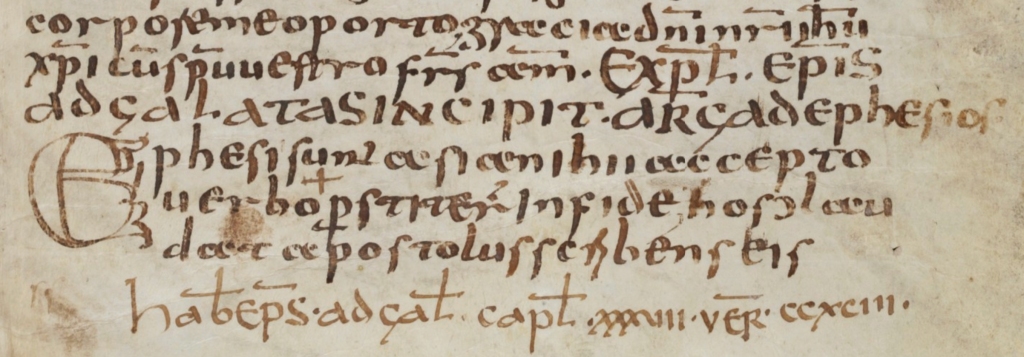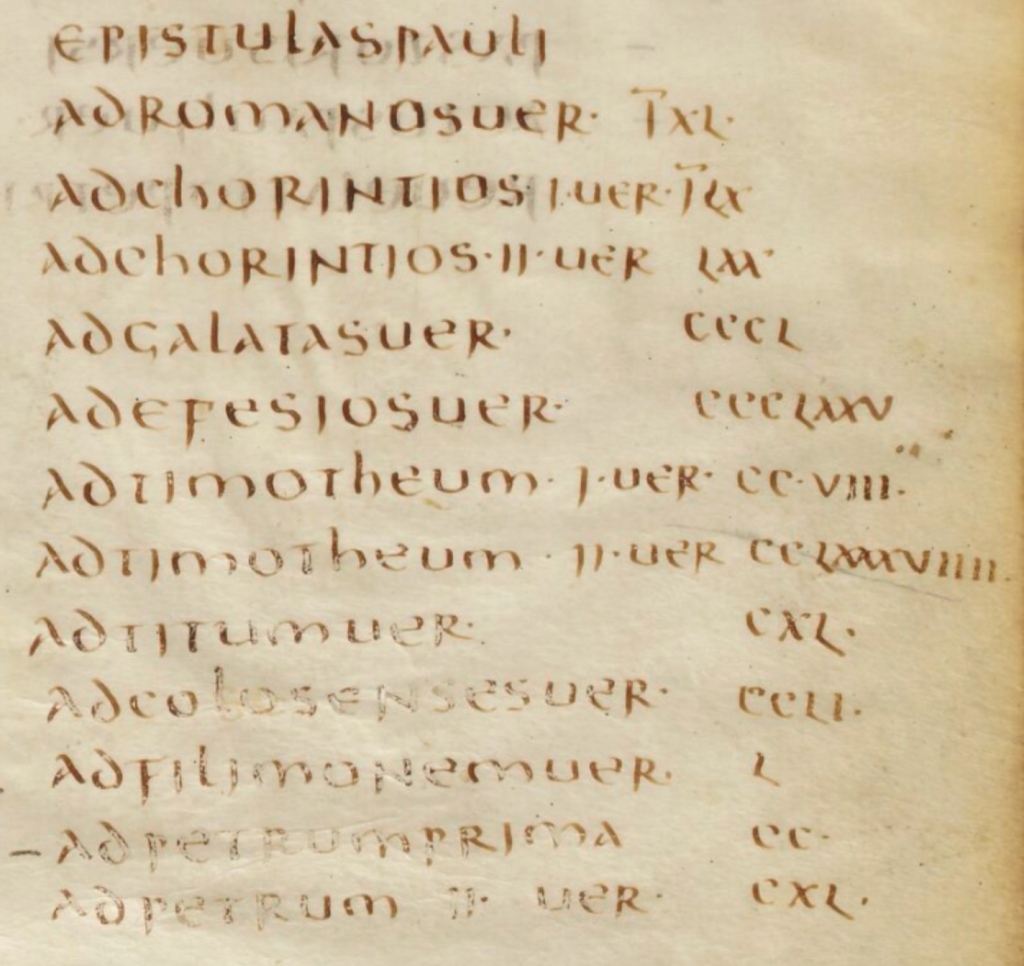In my earlier post on the stichometry of Greek manuscripts of Galatians, I was surprised to see that the “traditional” Greek stichometric count for Galatians (293 16-syllable stichoi) matched almost perfectly with the count for the text of the Nestle-Aland (when the latter was adjusted to account for nomina sacra). Earlier Greek manuscripts of Galatians, however, had different counts: Codex Sinaiticus with 312 and P46 with 375 (and the important minuscule 1739 had a count of 392). So, what about the Latin tradition?
I had expected that the Latin counts would be a bit lower just on the basis of Latin lacking definite articles. And a rough count of the Stuttgart Vulgate (3rd edition) for Galatians yielded 4804 syllables (that is, 300 versus of 16 syllables and a last line of 4 syllables), which is indeed a little lower than my rough count of Nestle-Aland 28 (303 stichoi + 11 extra syllables). But again, the subtraction of syllables to account for nomina sacra led to some surprising results (surprising to me, at least). Earlier Latin biblical manuscripts tend to contract a smaller set of words as nomina sacra than do their Greek counterparts, so I only subtracted syllables for this smaller set (forms of Deus, Christus, Iesous, and Dominus). That took away 108 syllables. So, we subtract 108 syllables from the the Vulgate Galatians 4804 syllables: 4804-108=4696. Divide 4696 by 16, and we get: 293.5. This is really quite close to the traditional Byzantine (Greek) count of 293. That seems like a very odd coincidence.
But what do the Latin manuscripts themselves say? Some Latin manuscripts do indeed give this number. Here is St. Gallen, Stiftisbibliothek Cod. Sang. 70, an 8th century codex of Paul’s letters:

Here the stichometric count is added in lighter ink at the bottom of the page after the Argumentum of Ephesians has already commenced: ver(sus) CCXCIII, 293. Other Latin manuscripts give a considerably lower number, such as the 9th century Bible, BnF Latin 1:

After the end title: hab(et) vers(us) CCXIII, 213 versus.1 How could the number be so low? I suppose it’s possible that the 293 syllables could be reduced by a count that took into consideration additional nomina sacra contractions and other forms of Latin abbreviation beyond nomina sacra, such as the relatively common dix(it), fec(it), –er(unt), etc. But I doubt this could reduce the count by 80 versus. I think an easier explanation would be an error, CCXIII for CCXCIII. But 213 is not the only other count given in the Latin tradition. The Latin stichometric list in Codex Claromontanus gives a (much) higher number:

Here, we get ad galatas ver(sus) CCCL, 350. So, not as high as the counts in P46 (375) and 1739 (392), but considerably higher than 293. I’m not sure how this count of 350 came to be. But there are a lot of strange things about this list.2 For now, I just note that the count for 2 Corinthians seems very low and that it is an odd coincidence that the count for Ephesians is exactly 375 (that is, the count for Galatians in P46). It makes me wonder if these counts simply became jumbled at some point(s) in their history.
Bayerische Staatsbibliothek Clm 6243, a miscellaneous codex of the 8th or 9th century, contains another biblical stichometric list in Latin, and the count for Galatians here is CCCXII, 312 (the same as what is found in Codex Sinaiticus):

Looking at the Roman numeral, I’m tempted to wonder if this also might be an error for 293: CCCXII for CCXCIII, but this would require both the transposition of the X and C and the loss of an I. Perhaps a better explanation would be to consider this a count based on stichoi of 15 rather than 16 syllables (see below).
At this point, it might be good to summarize the different stichometric counts we have found for Galatians in Greek and Latin witnesses:
- 293. This count is best attested, and as we have seen, matches up remarkably well with the actual number of 16-syllable stichoi in both Nestle-Aland 28 and the Vulgate.
- 213. This total may be a mistake due to the similar representation of 213 and 293 both in Roman numerals (CCXIII for CCXCIII) and in Greek numerals (ⲥⲓⲅ for ⲥҁⲅ).
- 312. This total may reflect a reckoning of stichoi based on 15 rather than 16 syllables (if we divide the Nestle-Aland total syllables by 312: 4684/312≈15.01). It may also be the result of misplacing the traditional count of Ephesians with Galatians.
- 350. I have no good explanation for this count.
- 375. I have no good explanation for this count.
- 392. This total may reflect a reckoning of stichoi based on 12 rather than 16 syllables, an iambic trimeter line rather than a hexameter line (if we divide the Nestle-Aland total syllables by 392: 4684/392≈11.95).3
- 393. This total is probably a mistake due to the similar representation of 393 and 293 both in Roman numerals (CCCXCIII for CCXCIII) and in Greek numerals (ⲧҁⲅ for ⲥҁⲅ).
So, of the seven reported counts, five have a reasonably good (or at least plausible) explanation. It would be nice to be able to explain the other two counts, especially the 375 stichoi in P46.
- Others among the “Tours Bibles” also give this count (see Köln, Erzbischöfliche Diözesan- und Dombibliothek, Cod. 1, fol. 365r and Bibliothèque nationale de France, Latin 3, fol. 375r). ↩︎
- See the interesting recent article by Kelsie G. Rodenbiker, “The Claromontanus Stichometry and its Canonical Implications,” JSNT 44 (2021) 240-253 https://doi.org/10.1177/0142064X211055647 ↩︎
- The tally of 392 that is found for Galatians in 1739 also appears in GA 436 (11th-12th century, Vat. Gr. 367, fol. 124v); GA 209 (14th century, Venezia Biblioteca Nazionale Marciana, gr. Z. 010, coll. 0394, fol. 146r; GA 205 (15th century, Venezia Biblioteca Nazionale Marciana, gr. Z. 5, coll. 0420, fol. 429r). ↩︎


Pingback: Stichometry 5: Problems with Metzger’s Stichometric Data | Variant Readings